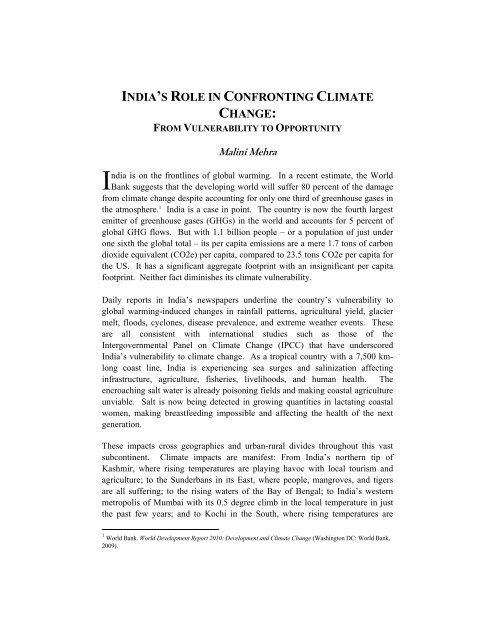Indian Climate Policy - Global Commons Institute
Indian Climate Policy - Global Commons Institute
Indian Climate Policy - Global Commons Institute
Create successful ePaper yourself
Turn your PDF publications into a flip-book with our unique Google optimized e-Paper software.
INDIA’S ROLE IN CONFRONTING CLIMATE CHANGE | 37<br />
I<br />
INDIA’S ROLE IN CONFRONTING CLIMATE<br />
CHANGE:<br />
FROM VULNERABILITY TO OPPORTUNITY<br />
Malini Mehra<br />
ndia is on the frontlines of global warming. In a recent estimate, the World<br />
Bank suggests that the developing world will suffer 80 percent of the damage<br />
from climate change despite accounting for only one third of greenhouse gases in<br />
the atmosphere. 1 India is a case in point. The country is now the fourth largest<br />
emitter of greenhouse gases (GHGs) in the world and accounts for 5 percent of<br />
global GHG flows. But with 1.1 billion people – or a population of just under<br />
one sixth the global total – its per capita emissions are a mere 1.7 tons of carbon<br />
dioxide equivalent (CO2e) per capita, compared to 23.5 tons CO2e per capita for<br />
the US. It has a significant aggregate footprint with an insignificant per capita<br />
footprint. Neither fact diminishes its climate vulnerability.<br />
Daily reports in India’s newspapers underline the country’s vulnerability to<br />
global warming-induced changes in rainfall patterns, agricultural yield, glacier<br />
melt, floods, cyclones, disease prevalence, and extreme weather events. These<br />
are all consistent with international studies such as those of the<br />
Intergovernmental Panel on <strong>Climate</strong> Change (IPCC) that have underscored<br />
India’s vulnerability to climate change. As a tropical country with a 7,500 kmlong<br />
coast line, India is experiencing sea surges and salinization affecting<br />
infrastructure, agriculture, fisheries, livelihoods, and human health. The<br />
encroaching salt water is already poisoning fields and making coastal agriculture<br />
unviable. Salt is now being detected in growing quantities in lactating coastal<br />
women, making breastfeeding impossible and affecting the health of the next<br />
generation.<br />
These impacts cross geographies and urban-rural divides throughout this vast<br />
subcontinent. <strong>Climate</strong> impacts are manifest: From India’s northern tip of<br />
Kashmir, where rising temperatures are playing havoc with local tourism and<br />
agriculture; to the Sunderbans in its East, where people, mangroves, and tigers<br />
are all suffering; to the rising waters of the Bay of Bengal; to India’s western<br />
metropolis of Mumbai with its 0.5 degree climb in the local temperature in just<br />
the past few years; and to Kochi in the South, where rising temperatures are<br />
1 World Bank. World Development Report 2010: Development and <strong>Climate</strong> Change (Washington DC: World Bank,<br />
2009).
















